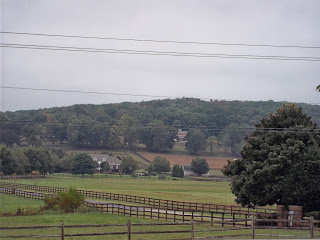 My husband and I celebrated our two years anniversary this
past June. To celebrate we spent a weekend in Birmingham, visiting a long list
of attractions. One of the great things about my husband is that, like me, he
loves touring historical spots. It doesn’t matter if it’s a big hot spot or
well known, as long as there is history there, we will go. A lot of our trip
consisted of places that dealt a lot with the heart of the growth of the Magic
City – iron. We visited Tannehill State Park and Museum, Vulcan Park, and the
most amazing – and creepiest – the Sloss Furnaces.
My husband and I celebrated our two years anniversary this
past June. To celebrate we spent a weekend in Birmingham, visiting a long list
of attractions. One of the great things about my husband is that, like me, he
loves touring historical spots. It doesn’t matter if it’s a big hot spot or
well known, as long as there is history there, we will go. A lot of our trip
consisted of places that dealt a lot with the heart of the growth of the Magic
City – iron. We visited Tannehill State Park and Museum, Vulcan Park, and the
most amazing – and creepiest – the Sloss Furnaces.
Now when my husband first gave me the details of our weekend
agenda – he is more OCD about planning trips than I am – I was a bit skeptical
about the Furnaces. For one, I had never heard of them and really didn’t know
what they were. And two, I thought, what’s so interesting about some furnaces
at a factory? The tour turned out to be the highlight of our trip.
Imagine pulling into a nearly vacant gravel parking lot. A
fence, tall and the gate a weird and almost unnerving design, outlines the huge
vicinity that feels empty and more than slightly eerie – even if it is the
brightest hour of the day. The only person working in the small office at the
gate doesn’t have a whole lot to say, although they will answer any questions
you ask. They hand you a brochure, numbers mapping out the path of your
self-guided tour. You step out of the quiet building and head to the first
marker on your map, only you are overly conscious of the towering faded black
and red, rust plagued furnaces that remind you of how small you really are. It’s
quiet. The only noise as you wind through the maze of dark passages and cluster
400-ton blast furnaces are your footsteps and the mingled sound of misplaced
creaks and dripping of water. You are sure to keep the conversation with your
party at a steady pace, just to be sure that you don’t hear anything more
unnerving.
 I describe it like this because the place – amazing, intriguing,
and breathtaking in all its rundown and colossal state – is really actually
quiet creepy. I’ve visited the Sloss twice this summer. Once with my husband
and then with a group of girlfriends. Both times I felt amazed and unnerved.
Just after my first visit, my husband and I decided to do more research on the
closed furnace complex and I was shocked and rattled to discover that it not
only listed as a historical landmark, but also listed to be "haunted."
I describe it like this because the place – amazing, intriguing,
and breathtaking in all its rundown and colossal state – is really actually
quiet creepy. I’ve visited the Sloss twice this summer. Once with my husband
and then with a group of girlfriends. Both times I felt amazed and unnerved.
Just after my first visit, my husband and I decided to do more research on the
closed furnace complex and I was shocked and rattled to discover that it not
only listed as a historical landmark, but also listed to be "haunted."
In honor of Halloween, I’m sharing a bit of the Sloss
History, real and haunted with you today.
A bit of background history: The Sloss Furnace operated as
pig-iron producing blast furnace from 1882 to 1971. Colonel James Withers
Sloss, one of the founders of Birmingham, formed his own company – Sloss Furnace
Company – and built the first blast on 50 acres of land. Sloss retired in 1886,
selling the company to a group of investors, who moved the furnaces through
rapid expansion. For those who do not know much about the production of such
metal, it is a dangerous – very dangerous – job. So, needless to say, there are
countless stories that involve injuries and death at the furnace.
And just to show how famous the Sloss really is, the landmark
has been the focal point in episodes of the shows “Ghost Hunters” and “Scariest
Places on Earth,” and others. Now, to be
honest, I’m not really sure what I believe with the whole “paranormal” stuff,
but in truth, this place will raise questions.
 Back to the danger of working at the furnaces….The shifts
are long and grueling. For the men who casted the liquid metal under the open
pavilion, carefully maneuvering around the glowing golden liquid, they were hired to endure
hours confined to the close proximity of temperatures well over hundred. In the
summer it was unbearable and in the winter not much better – one side of
your body felt almost on fire, while the other half was frozen from the biting
cold. Men were cautious with each trained step, fearful to lose balance or misstep.
How many times had they seen a friend make a simple mistake and topple into the
barrels of the heated furnaces?
Back to the danger of working at the furnaces….The shifts
are long and grueling. For the men who casted the liquid metal under the open
pavilion, carefully maneuvering around the glowing golden liquid, they were hired to endure
hours confined to the close proximity of temperatures well over hundred. In the
summer it was unbearable and in the winter not much better – one side of
your body felt almost on fire, while the other half was frozen from the biting
cold. Men were cautious with each trained step, fearful to lose balance or misstep.
How many times had they seen a friend make a simple mistake and topple into the
barrels of the heated furnaces?
It's details like that that come with many of the stories of
the Sloss Furnaces. One of a man who lost his balance and did plummet into the gleaming
metal, more like lava. The only trace of him recovered was a shoe. In the
Boiler Room – which is usually locked up, but on my second visit was not – men
were burned to the point of unrecognition as machines and pipes exploded.
Sadly, one man ate his lunch near one of the ginormous churning wheels, only
for the hem of his coat to get winded through, dragging him along with it. The
stories are endless. Quite sad, horrifying, unbelievable, but very true.
 |
| Creepy tunnel that gave me goosebumps! |
Like embarking a ship with a dark past, if ever we could the
Titanic, an overwhelming sense of the depravity and loss of life is almost
overwhelming to soak in. The sadness, mysteriousness, and evilness is like a
thick veil that swallows you as you tour the grounds.
Don’t get me wrong, the trip is well worth it. It’s really
enlightening. But I will not deny that I ran out of the pitch black, cold and
damp, underground boiler room when I heard a clang that could not be explained
that mingled with the suppressed lung crunching frightening sensation. Yes, I
left my sister and friends at the bottom of the rickety stairs while exclaiming,
“Shut the front door!” as my only means of venting my startled fear. My brave
younger sister got a good laugh out of my jitters.
Now, I did say the place is “haunted.” I have not seen
personal proof, other than my unsettled fears. But countless stories are told
by others who have experienced such ghostly encounters. The household name
Slagg is just as famous as the pig-iron itself that was produced at the Sloss.
 Slagg was the foreman that will always be known for his
reputation to have worked his employees to death – literally. Stories say that
he was hated so much that he was eventually pushed into one of the furnaces.
Now he haunts the maze of pipes and can be seen at times walking the boardwalk
down the heart of the boilers that rise tall like cathedrals.
Slagg was the foreman that will always be known for his
reputation to have worked his employees to death – literally. Stories say that
he was hated so much that he was eventually pushed into one of the furnaces.
Now he haunts the maze of pipes and can be seen at times walking the boardwalk
down the heart of the boilers that rise tall like cathedrals.
In the end, I give my visits to the Sloss Furnaces an
A+ for its plethora of history,
awe-moments, and definite creepiness. If you seek to visit a place for thrill
and education, it will not disappoint. Neither will it dissatisfy those who are
eager to have the hairs on the back of their neck stand straight up.
Personally, I plan to go again. Not so much to get scared,
but to dig deeper into the hidden crevices and unearthed stories that are
waiting to be told. Who knows, maybe I’ll use it for a setting of a book one
day. Oh, and if you do go, be sure to see if you can find any long forgotten pieces
of coke (processed coal). My husband and I found a rather good size piece and brought it home.








